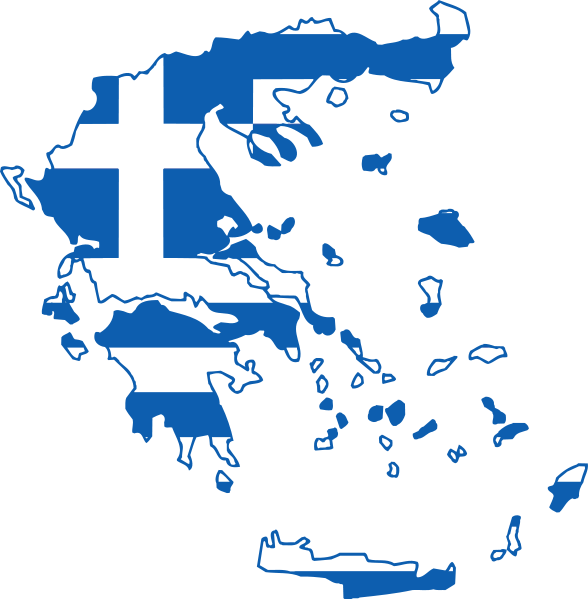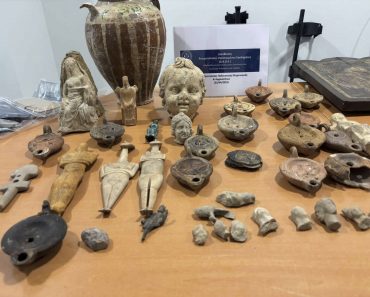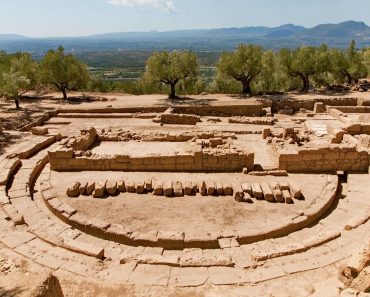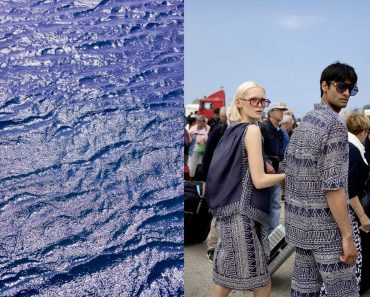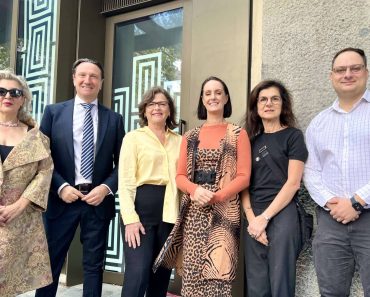This article was produced by National Geographic Traveller (UK).
As the sun sinks towards the serrated horizon of the distant Pindus Mountains, the assembled congregation grows quiet. There are perhaps 40 people gathered here, each occupying their own smooth knuckle of the lofty outcrop. Some have been present an hour or more, watching the day slowly drain from this extraordinary landscape. Others, such as myself, a matter of minutes — fortuitously passing Meteora’s most celebrated sunset spot as dusk closes in.
It’s quite the vantage point: all around, thrusting upwards through the densely forested valley floor, are the gargantuan pillars of sandstone rock for which the area is renowned. In places, these are as smooth and uniform as the funnel of a steamship. Others resemble giant shark fins or the horn of an enormous saddle.
Geologists explain this wildly anomalous landscape, erupting from the featureless plains of Thessaly in northwest Greece, in terms of tectonic movement, vertical fault lines and millions of years of erosive action. But this seems altogether too logical. Too prosaic. There’s a palpable aura and mysticism to Meteora, one that has made it a beacon of spirituality for more than a millennium.
The imprint of this is everywhere, from the hand-chiselled caves of the 11th-century ascetics — some still crosshatched with rickety wooden platforms — to the defunct hermitages secreted into clefts high up in the rock faces. Here, until the advent of organised monasticism six centuries ago, hermits would pass lifetimes of abject deprivation, glorifying God with their self-denial.
Most conspicuous are the six remaining inhabited monasteries. With a sweep of the head, each is visible from where I sit, clinging to their respective pedestal-top eyries with talons of centuries-old brickwork. The monasteries’ exalted setting — some of the stone pillars are almost 1,800ft high — is borderline miraculous. Fall from these structures, as monks often did during their perilous, devotion-proving construction, and you’d have many moments of tumbling contemplation.
When travel writer Patrick Leigh Fermor visited in the 1950s, he found the monasteries of Meteora in a wretched state. “Some of the doors of the empty cells [hung] open. Others were closed with twists of wire, and last year’s leaves blew about the wide wooden halls,” he wrote.
Today, supported by a well-managed visitor programme, they’re immaculate, with robust walls and red roof tiles that glow like the embers of the day. “What you must appreciate,” local guide and historian Vasilis Kiritsis tells me, “is that this is a place where both nature and mankind are at the very top of their creative games.”

Altars at Agios Nikolaos Anapafsa are elaborately decorated in dedication to the ‘new martyrs’. Photograph by Francesco Lastrucci
The scholar monk
The biggest, oldest and highest of the half-dozen monasteries of Meteora is Great Meteoron. It was established, brick by laborious brick, during the 14th century by scholar monk Athanasios and his followers, who departed Mount Athos — Greece’s other great monastic hub — in search of a new place of protection and solitude.
I arrive early the following morning, eschewing the road from the adjacent village of Kastraki to the base of the pinnacle in favour of the looping three-mile footpath that rises through the forested flanks to the north. A canopy of beech, oak and Aleppo pine filters the morning sunshine and there’s a whisper of a breeze. A trio of rock climbers — relying on belays and ropes rather than sandals and prayer — passes by with a jovial ‘kalimera’ (good morning).
As I emerge onto the plateau, the monastery abruptly appears. I’m thrown by its scale: more Tuscan hilltop village than simple sanctuary. Organised monasticism in Meteora flourished in the 15th and 16th centuries as monks sought to escape persecution during the Ottoman occupation of Greece. At its peak, two dozen Greek Orthodox monasteries were dotted across these rocky pinnacles and 300 monks inhabited Great Meteoron alone.
Whereas monks and building materials were once winched up to the lifting tower by ropes that would break when they broke (God’s will, apparently), access today is via more than 300 steps, hewn from the rock. I puff my way to the top in a slow-moving but good-natured line of visitors and spend a contemplative hour strolling the flower-ringed courtyards and polished timber walkways.
The katholikon (main church) is particularly compelling. The skull of Athanasios is on display in a niche, encased in an elaborately decorated silver reliquary whose circular lid is open, revealing brittle, ghostly white bone. It sounds a ghoulish note, one amplified by the gratuitously detailed 16th-century paintings that adorn every inch of the walls and cross-vaults — many showing the plight of the so-called ‘new martyrs’. These clergymen and laypeople submitted to elaborately cruel deaths to demonstrate their faith during the Turkish occupation. The calm acceptance on their faces is almost as unsettling as the flaying, burning and sawing depicted.

The steps up to Great Meteoron, the largest monastery in Meteora, slope along the rocky cliffside. Photograph by Francesco Lastrucci
Unique bond
Swallowed by the crowds, or more likely squirrelled away in prayer, Great Meteoron’s six resident monks are nowhere to be seen. That’s not the case in the lesser-visited monasteries. Approaching the smaller Agia Triada, set on a towering thumb of rock around a mile to the south, I spot a box being winched across the chasm towards it. It’s steely grey, with small rectangular windows, and little bigger than a photo booth.
This, I learn, is how the handful of monks who reside here come and go on the rare occasions they’re allowed to do so. I miss a sighting of the returnee, but the views from the sun-warmed terrace of the monastery — accessed via steep, corkscrewing steps from the wooded ravine below — offer plenty of consolation. Kalabaka, Kastraki’s larger neighbour, unfurls in a carpet of terracotta rooftops 800ft below and the hazy, parched expanse of the Thessalian plain stretches away into the distance.
It’s an unfortunate irony that Meteora’s resurrection over the past 40 years is owed to a character who’s not exactly a paragon of monastic self-denial. Agia Triada doubled as the clifftop lair of villain Aristotle Kristatos in the 1981 Bond film For Your Eyes Only, and Roger Moore’s scaling of this very pinnacle (aided by ropes, and cinematic smoke and mirrors) sparked interest in this moribund religious site.
“It was the first time the world really had a chance to see this extraordinary place, and it made Meteora famous on a global level,” explains Vasilis, who works for local guiding organisation Meteora Trip. World Heritage status soon followed, and demand for visits has stayed high ever since.
The selfie-snapping twentysomethings on the Agia Triada terrace look way too young to remember Moore, or indeed the 1980s. Not for the first time, I’m struck by the inherent contradictions of Meteora: the materialistic and the monastic; the excess and the restraint; the outsider’s fleeting aesthetic gratification and the resident’s lifetime of soul-searching devotion.

Monk Fotios is one of only three monks who live at Agios Nikolaos Anapafsa. Photograph by Francesco Lastrucci
Life of solitude
Such tensions I put to Monk Fotios, who I meet the following day, ghosting through the narrow corridors of Agios Nikolaos Anapafsa. Sitting behind the desk at the entrance is an earnest young man who is annotating a religious text in lulls between collecting the €3 (£2.50) admission fee. He agrees to serve as translator as I engage the monk in halting conversation.
Fotios — monks must adopt a single, religiously significant name — is dressed entirely in black, with a pallid complexion and piercing eyes. His beard is long but not full, like overstretched cotton wool. He’s one of just three monks who live here, I’m told. An honour? “I don’t see it like that.” How does he reconcile his life of prayer and solitude with the constant visitors? “It’s the staff, not the monks, who have to deal with the people,” he says, staring detachedly at a small group who’ve just arrived. “Most of the time we are closed inside our rooms.”
Fotios has been at Agios Nikolaos for six years, and has spent 11 as a monk. He’s one of almost 90 men and women spread around the 12 monasteries and nunneries in Meteora and the surrounding district. Many of the most recent intake are university educated; some are former doctors, teachers, lawyers. But this is no whimsical career break: vows of poverty must be sworn; family shunned. Fotios fixes me with those intense eyes. “Every day we must struggle and fight with our desires. The biggest gift is to set ourselves free from pleasures.”
Behind him are the faded 14th-century frescoes of the monastery’s chapel. Soft sunshine filters through the slender rectangular window, glinting off the ornate chalices and incense burners. Outside, a cloudless sky is framing one of the world’s most compelling vistas.
It would take heroic self-possession, I think, not to find pleasure in so much beauty. And in that sense, for the current residents as for the ranks of the devoted who’ve passed through this enigmatic place over the centuries, perhaps Meteora is the perfect testing ground.
How to do it
This story was created with the support of Natural Adventure Co.
To subscribe to National Geographic Traveller (UK) magazine click here. (Available in select countries only).
